Corks $ Curls: How did the death of a 119-year old UVA tradition go unnoticed?
After a 119-year run, Corks & Curls, the student yearbook first published in 1888, disappeared without anyone really noticing. On Thursday, January 21, following up on rumor that the storied yearbook had been nixed, the Hook asked UVA Dean of Students Allen Groves if it were true. Groves passed the inquiry on to Karen Shaffer, UVA’s director of Student Activities.
“The Corks & Curls yearbook is traditionally published by UVA students, but the group is currently not active,” said Shaffer. “While they may choose to regroup and publish a yearbook in the future, there is no plan to do so in the 2009-10 academic year.”
Yikes! How could a University steeped in history allow one of its oldest traditions to perish? Was it a funding issue?
“Not so much a funding issue, as a sign of the times,” said UVA spokesperson Carol Wood the next day. “Apparently, there was little interest on the part of students to want a yearbook, as more and more students were deciding not to purchase them. I have heard this happening elsewhere.”
So what did the UVA students think? We asked Cavalier Daily editor Andrew Baker, who said the yearbook hadn’t been making much of an impression.
“I haven’t seen much publicity or presence from the yearbook around Grounds in the four years I’ve been here,” he said.
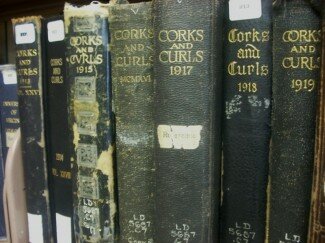 “Anyone who takes a few hours to glance through the editions from the late 1800s to the 21st century will almost certainly enjoy these time capsules,” says UVA's Larry Sabato
“Anyone who takes a few hours to glance through the editions from the late 1800s to the 21st century will almost certainly enjoy these time capsules,” says UVA's Larry SabatoPHOTO BY DAVE MCNAIR
“I’ve tried testing the waters with some of my friends, casually mentioning that the yearbook isn’t going to be published,” said fourth-year UVA student and Hook music writer Stephanie Garcia, “and no one seemed to really care.”
However, the news came as a shocker to historian and radio host Coy Barefoot, who says he drew heavily on archival copies of Corks & Curls in compiling his own book, The Corner: A History of Student Life at the University of Virginia.
“It’s a prime historical resource,” says Barefoot, who is teaching a local history course this semester. “This is just awful from a historian’s standpoint.”
With pages dedicated to everything from wild fraternities to bookish honorary societies, from dormitory life to athletic teams, cultural events, and visiting VIPs, Corks & Curls covered extensive territory. Indeed, taken as a whole, browsing through issues of Corks & Curls amounts to an intimate journey through the history of American culture over the last 119 years. What historian wouldn’t shed a tear at its loss?
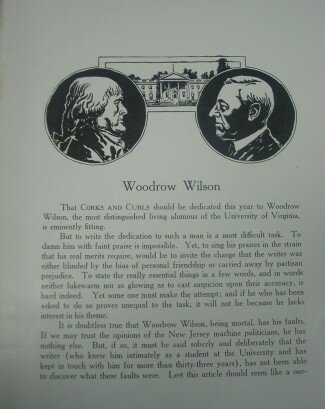 The 1913 edition of Corks & Curls was dedicated to alum Woodrow Wilson, who became the 28th President that year.
The 1913 edition of Corks & Curls was dedicated to alum Woodrow Wilson, who became the 28th President that year.PHOTO BY DAVE McNAIR
“Anyone who takes a few hours to glance through the editions from the late 1800s to the 21st century will almost certainly enjoy these time capsules,” says Larry Sabato, the noted political analyst and UVA professor, who still owns the four Corks & Curls published during his undergraduate years in the early 1970s. “Tradition is important at the University of Virginia, and there is one fewer good one now.”
An even bigger shocker, the Hook would learn from UVA alum Aaron Josephson, who serves on the executive committee of the Class of 2009, was that the 2009 edition of Corks & Curls had not been published either. What?! Oddly enough, while UVA officials quickly confirmed the demise of 2010 edition, they appeared unaware of the missing 2009 edition.
Indeed, when the Cavalier Daily and the UVAToday blog finally ran brief stories about the demise of the yearbook the following Monday, there was no mention of the missing 2009 edition.
***
When the yearbook was first brought to life in 1888, the name– originally chosen at random– was ascribed an arcane meaning via a contest won by med student Leander Fogg, who reasoned that “corks” were students who didn’t know what to say when called upon in class (like corks silently plugging a bottle), whereas “curls” were students who knew all the answers, as one who “curleth his tail for delight.” A few years later, the student publishers– all men in a pre-coeducation UVA– described their book:
“A monument raised by the students, to be a memorial to them of each other, of the University, and of all things common to them and to the University.”
In effect, it was a 19th Century version of social media, something that allowed students to preserve a shared experience. Ironically, its 21st Century’s versions, Facebook and MySpace, appear to have made the idea of a printed yearbook somewhat obsolete.
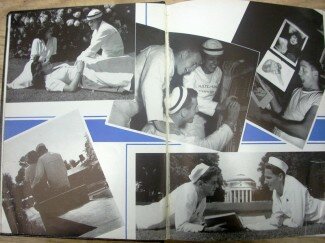 Naturally, the 1944 edition of Corks & Curls presented the war-time atmosphere.
Naturally, the 1944 edition of Corks & Curls presented the war-time atmosphere.PHOTO BY DAVE MCNAIR
“Most college students are not interested in buying a yearbook in which they do not appear, as posing for pictures was voluntary,” says one recent editor, who spoke on condition of anonymity. “If they want to reminisce, they can just look at their friends' pictures online.”
“I remember that we had a difficult time selling books and getting students to get their photos taken when I was on staff,” says 2005 UVA alum and four-year staffer Whitney Spivey, who curated a 2004 exhibition in the Rotunda, 116 Years of Corks & Curls.
Indeed, in the last few years, as spokesperson Wood pointed out, college annuals across America have seen shrinking sales as free media blossoms, but UVA appears to be the largest and most prominent university losing its yearbook.
“Our latest research indicated that slightly over 1,000 colleges and universities continue the tradition of print yearbooks,” says Rich Stoebe, communications director for Jostens, a leading yearbook publisher. While high schools and elementary schools continue to publish yearbooks at a steady clip, says Stoebe, there has been a decline in college yearbooks that began a number of years ago.
Stoebe blames larger and more diverse student populations for the decline, and suggests that more mature college-aged students tend to lose interest in the idea of yearbooks.
However, that doesn’t appear to be the case up in Boston.
“Harvard Yearbook is still doing great,” says yearbook president Kelsey Han. “Our numbers have actually improved over the years, and a great majority of the senior class purchases a yearbook. This year, we had over 95 percent of the senior class take their senior portrait.”
Of course, Harvard has a smaller undergraduate student population, roughly 6,700, compared to about 13,700 at UVA. However, the total student population at the two schools, including graduate students, is about the same at 20,000.
“When I attended UVA as a student, it was 10,000, as opposed to around 20,000 now,” says Sabato, who cites this rough doubling in population as a key factor in the yearbook’s demise. “At 10,000," he explains, "your community is small enough so you can keep up with just about everyone in your class, and you know a good bit about people in other classes. At 20,000, atomization– necessary for individual happiness– has occurred.”
However, some ex-staffers are laying the blame for the yearbook’s exit on management and finances, not Facebook, student population growth, or lack of interest.
“Corks & Curls did not fall because of Facebook or any other social media fad,” says 1994 editor Vickey Wolf. “ Certainly, college yearbooks across the nation have struggled recently–- and Facebook has been an easy target, but I sincerely doubt that college students view Facebook as a replacement to their college yearbook.”
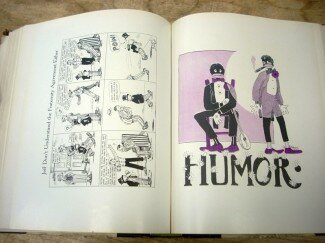 What passed for college humor in the 1920s would get you in a heap of trouble today.
What passed for college humor in the 1920s would get you in a heap of trouble today.PHOTO BY DAVE MCNAIR
“There were financial issues due to decreased sales and staff as well as a couple years of poor management,” confirmed our anonymous editor. “It was essentially run as a small business staffed by students. Obviously, when a business doesn’t have enough people or sales to support operations, it closes.”
“It was a difficult decision, and one that the staff regretted because of the tradition,” said Michelle Burch, co-editor of the missing 2009 edition, who blamed declining sales, networking websites, and financial insolvency for the yearbook’s demise.
“We had great interest in keeping the book alive, but overall student interest and the financial reality of publishing it in its traditional form make that very difficult,” said Burch.
“The book has always been a hard sell because of the sheer size,” explains ex-staffer Anthony Whitten. “It was a 400-plus page book that covered close to 20,000 people. Most people didn’t think they would be featured.”
Whitten, who was the Corks & Curls business manager from 2000 to 2003, says it cost $100,000 to $120,000 to create about 1,600 copies.
“The book was relatively affordable,” says Whitten. “It cost less than most books students purchased in high school.”
The missing 2009 edition, Shaffer says, would have sold for $85 a copy.
To Whitten, who says he was “completely devastated” about the news about the oldest publication on grounds, it was the 2003 shift from spring to fall publication that doomed Corks & Curls.
“It’s hard to sell a book to seniors,” he explains, “after they have graduated and are no longer at the University.”
Indeed, according to our anonymous editor, only about 250 copies of the 2008 edition were sold. At $85 a piece, that’s just $21,250, or just a fifth of the budget five years earlier and nowhere near enough to pay all the bills.
“Switching to Fall delivery was a huge mistake which led to debt incurred from mailing costs and ultimately, reduced sales in the subsequent years,” says former editor Wolf, now marketing director for North Carolina-based yearbook publisher Herff Jones.
Wolf calls herself a “big fan of student self-governance,” but says the yearbook could have used some “adult guidance” in some of its bigger decisions. “With new students part of the decision-making mix every year, they tended to make decisions at the whim of the new group, “ she says.
Wolf also wonders why the organization, which operates as a Contracted Independent Organization (CIO), didn’t contact the Alumni Association when its business was imploding. In 1992, she says, the Association lent Corks & Curls $20,000 for new computers. Wolf also suggests that not enough was done to market the relevance of the yearbook to students.
“The Association is there to help student organizations in situations like this,” says Wolf. “Did Corks & Curls solicit requests from C&C alumni for donations? I haven’t received that kind of request since the very early 2000s.”
While Burch has said the decision not to publish the 2009 edition was made after the release of the 2008, a reliable source tells the Hook that the 2009 edition was actually completed and sent to the publisher, but that the student-run organization simply couldn't afford to have it printed.
“I don’t know if that is the case or not,” said Shaffer when asked about the debt problem and the “lost” 2009 edition. “I know they had been working on it, but I don’t know if they completed it prior to the decision not to publish.” She deferred the question to Burch, who failed to respond despite numerous requests for comment.
“It’s clear that the 2009 editors just want to put this all behind them and have no interest in kicking things up again,” says our anonymous editor.
Indeed, there’s a lot that UVA officials appear not to know, as Corks & Curls was a completely student-run operation. Meanwhile, alums like Wolf hope to generate enough interests among fellow alums and students to resurrect the yearbook, and they want UVA’s support.
“Given the reputation and recent poor press,” says Wolfe, “ it may take some University support or involvement to help it get back on its feet. I don’t necessarily see that as a bad thing.”
Of course, if Corks & Curls were raised from the dead, it may have to adapt to a high-tech world and abide by the balance sheet.
For that, Yearbookalive.com sales associate Corey Richardson thinks he might have a deal.
“Say you have 500 students interested, and you sell your yearbook CDs for $20,” says Richardson, who sells digital yearbooks on CDs and DVDs, a medium that can hold thousands of photos, videos, music, and other information. “Minus $499 for our software, and about $500 for the CDs, that’s a $9,000 profit.”
As Richardson points out, there are no pesky print deadlines, and the CDs can record far more information than a 400-page book can. Besides, one could still publish a slimmer print version of the yearbook that had a CD tucked inside, he says.
Still, there’s something powerful about standing in front of a stack of old books in the reference library at Alderman, picking a year, and holding the weighty volume in your hands.
“I understand there’s something to be said for the immediacy of capturing college memories via the Internet,” says Spivey, “but in my mind, digital media will never be able to compete with a 400-plus page book that completely and accurately documents every aspect of life at the University.”
Spivey says she took great pride in creating a piece of UVA history that her classmates would carry with them for the rest of their lives.
“Each year has its own personality,” she says, “from the material on the cover to the issues discussed inside. I think it’s a shame that this tradition will end. The books are a valuable gauge of the University’s views and values throughout history.”
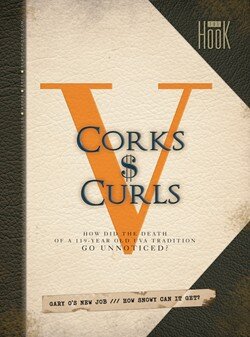
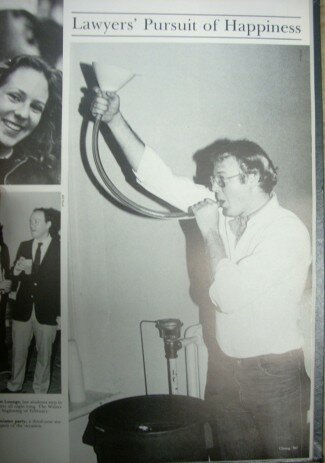
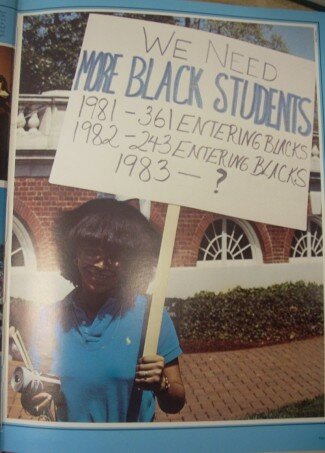


12 comments
Dakota, crozetette, Gasbag, cvllelaw...
I'd ask that you not discuss another story on this thread. Thanks for your consideration.
Dave McNair
I was a yearbook photographer my first year at Uva (1992). I have fond memories of it but since I graduated in 1996 I have not opened any of the 4 yearbooks I purchased. They look nice in my bookcase but I don't think they were worth the money.
Showing my age here, but photos used to be taken at in person class registration (last done in Spring '93 I believe). With online registrations many folks never appeared in the yearbook.
the right people can make this book successful. facebook is not a memento of 4 years, and nobody in 15-20-40 years will have social website that condenses a college experience in one conscise book. facebook wont exist in 2 yrs, it will have been replaced with something else. there is still value in the book. whoever does this next needs to be more creative from a business perspective and how the book is assembled and moved to a spring delivery. there needs to be a social site that kids use that somehow ties into this book and makes those pictures and comments available to the publication. solving this will be about hooking up new and old media, but if you do it, it can be done.
notice a webpage of JRKs assassination is worth nothing, zilch; but a copy of time or the NYtimes from that day is worth money. same for a yearbook.
lazyness and lack of creativity killed it. probably needs to be a 3rd party service do it whose only job is to make money by selling it. kids are moving on and trying to find jobs, not sell a book by the end of their 4 yrs.
correction: facebook wont exist in 20 years
Unnoticed? NBC29 did the story almost a month ago.
With all the social networking sites and everyone having a camera of somesort. I'm not really surprised that yearbooks are going the way of the dodo. I dont think I've opened up my highschool yearbook since I was in highschool 10 years ago. Also with the economy the way it is, people are not spending $$ on things they dont really need.
I graduated in 2002 and can't recall ever seeing any of my friends with a yearbook during my four years or since.
Yearbooks are really booming here in the UK where it's still a very immature market. The key is to engage people by creating them online.
i admit i rarely open my old corks and curls. but when i do, yes there are memories. and it is an historical record of sorts. if the price wasn't so prohibitive, i think more students would buy it. when i graduated in 88 it was around $60; i can only imagine what it is now. kind of reminds me of the pep band - another lost tradition.
NBC 29 and...
I read this story in UVA Today several weeks ago. I think your headline is deceiving. The Hook didn't notice (which you might not want to point out), but it wasn't a secret by a long shot.
Someone at the Hook needs to sign up for the University's releases:
http://hoosonline.virginia.edu/site/c.ihLPKVPGLuF/b.4624369/k.21B5/UVa_T...
@ Royal Guard --Noticed ? So did the Hook a month ago, and they the were the ones to notice that "Indeed, when the Cavalier Daily and the UVAToday blog finally ran brief stories about the demise of the yearbook the following Monday, there was no mention of the missing 2009 edition."
I admire the staff of the Hook, they always dig deeper and find the back story, that often, the powers that be, preferred not be told.
Great job Dave, this will be a great reference and history for those who wonder --what happened ?
http://readthehook.com/blog/index.php/2010/01/25/unfriended-uvas-cor...